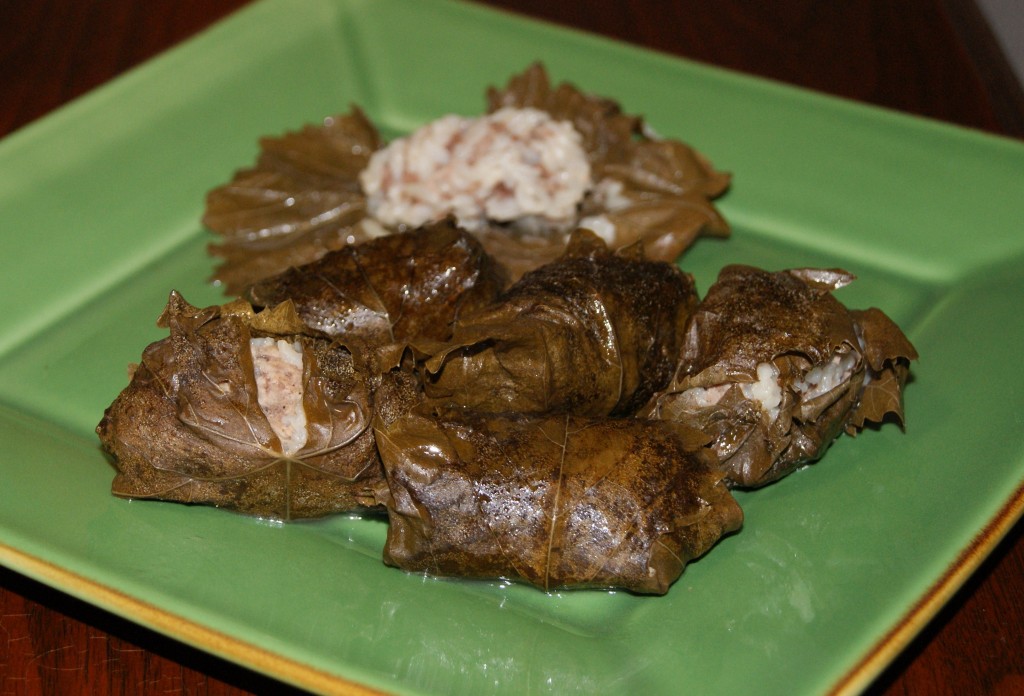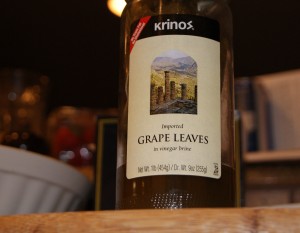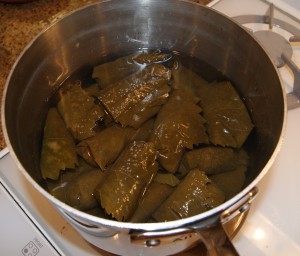 It started with a hummus sandwich. Austin’s local sub shop chain, Thundercloud Subs [1] really began my voyage into Mediterranean and Middle Eastern cuisine. As a child I was hardly an adventurous eater, a habit that only slowly began to change in my early 20’s. For my entry to challenge #2 for Project Food Blog 2010, I prepared Lamb and Rice Stuffed Grape Leaves to showcase my ability by tackling a classic dish from another culture. This is probably about as far out of my comfort zone as I can imagine. I have never cooked or witnessed any form of lamb being prepared. Outside of a restaurant, I’ve never seen a grape leave. I love taking on new ingredients, and believe cooking is all about taking your fundamental building blocks and combining them to build truly great flavor in different and inspiring ways.
It started with a hummus sandwich. Austin’s local sub shop chain, Thundercloud Subs [1] really began my voyage into Mediterranean and Middle Eastern cuisine. As a child I was hardly an adventurous eater, a habit that only slowly began to change in my early 20’s. For my entry to challenge #2 for Project Food Blog 2010, I prepared Lamb and Rice Stuffed Grape Leaves to showcase my ability by tackling a classic dish from another culture. This is probably about as far out of my comfort zone as I can imagine. I have never cooked or witnessed any form of lamb being prepared. Outside of a restaurant, I’ve never seen a grape leave. I love taking on new ingredients, and believe cooking is all about taking your fundamental building blocks and combining them to build truly great flavor in different and inspiring ways.
 To start my background information, I went to the best source I could find. My dear college friend, Christina, married a man of Lebanese descent. Last fall, when I embarked on my homemade pita experiment [2], the best recipe by far was adapted from their staple cookbook. They lent me their copy of Lebanese Cuisine, which has had 13 editions and is largely considered one of the classics for this region. There aren’t any pictures, but thank goodness for bloggers, right? In the next five years everything ever created in food to date surely will have been prepared, reviewed, photographed and covered by a food blogger. (wink)
To start my background information, I went to the best source I could find. My dear college friend, Christina, married a man of Lebanese descent. Last fall, when I embarked on my homemade pita experiment [2], the best recipe by far was adapted from their staple cookbook. They lent me their copy of Lebanese Cuisine, which has had 13 editions and is largely considered one of the classics for this region. There aren’t any pictures, but thank goodness for bloggers, right? In the next five years everything ever created in food to date surely will have been prepared, reviewed, photographed and covered by a food blogger. (wink)
The first challenge in the project was locating the grape leaves. I found them at Central Market, though I’ll admit it did take me two trips through the store.  They were located in the pickles and olives section, next to some canned dolmas. Dolma is a word of Turkish etymology meaning stuffed vegetable – frequently grape leaves. The Lebanese name for this dish is Mihshi Waraq Inab, but the dish is made similarly under many names in the entire region, from Greece to Egypt to Iran to Armenia and everywhere in between. The origination of this dish is muddy at best, likely due to it’s birth in a region known as the cradle of civilization.
They were located in the pickles and olives section, next to some canned dolmas. Dolma is a word of Turkish etymology meaning stuffed vegetable – frequently grape leaves. The Lebanese name for this dish is Mihshi Waraq Inab, but the dish is made similarly under many names in the entire region, from Greece to Egypt to Iran to Armenia and everywhere in between. The origination of this dish is muddy at best, likely due to it’s birth in a region known as the cradle of civilization.
 I like to think of stuffed grape leaves like Middle Eastern Sushi. I thought the filling had a fabulous flavor, slightly citrus, slightly salty, and was blown away by the delicate texture of the lamb. Somehow combining ground lamb with rice and a few seasonings, wrapping and covering with water, then cooking for a short time, didn’t seem possible to create such a flavorful dish. I do think my wrapping skills could use a little practice to gain a tighter, more compact roll, and possibly they could have been cooked longer to yield a slightly more tender leaf. Next time, I’d probably try to seek out fresh grape leaves just to taste the difference.
I like to think of stuffed grape leaves like Middle Eastern Sushi. I thought the filling had a fabulous flavor, slightly citrus, slightly salty, and was blown away by the delicate texture of the lamb. Somehow combining ground lamb with rice and a few seasonings, wrapping and covering with water, then cooking for a short time, didn’t seem possible to create such a flavorful dish. I do think my wrapping skills could use a little practice to gain a tighter, more compact roll, and possibly they could have been cooked longer to yield a slightly more tender leaf. Next time, I’d probably try to seek out fresh grape leaves just to taste the difference.
Lamb and Rice Stuffed Grape Leaves Recipe – Mihshi Waraq Inab
adapted from Lebanese Cuisine by Madelain Farah
1 jar grape leaves
1 c. uncooked rice
1 lb. ground lamb
1/8 tsp cinnamon
1/8 tsp allspice
kosher salt
fresh ground pepper
1/4 c. lemon juice
Pour rice in a strainer, then rinse until water runs clear. Drain then pour rice into bowl. Add lamb, cinnamon, allspice, 1 tsp kosher salt and 12 turns pepper, then use hands to thoroughly combine.
In a 3 qt sauce pan, use a few of the torn grape leaves to cover the bottom of the pan. This will prevent the stuffed leaves from sticking. In a large bowl of hot water, rinse grape leaves and soak for a few seconds before filling. Spread a grape leaf flat with the shiny side facing down.
 Then place a small amount of filling in the center bottom of the leaf. Roll the bottom leaves up, then roll the side leaves in to create a packet.
Then place a small amount of filling in the center bottom of the leaf. Roll the bottom leaves up, then roll the side leaves in to create a packet.  Continue rolling towards the top of your board to create a tight cylinder.
Continue rolling towards the top of your board to create a tight cylinder.
The notes in the recipe I was referring to indicated that if you just covered your stuffed grape leaves with water, all the water would be absorbed when ready. This was definitely not the case for me, even with extra cooking time, so I’m going to note the next picture – as how *NOT* to place your stuffed grape leaves. I’d advise trying to line the whole edge in a ring – with a base of each cylinder touching the outside of your saucepan. The key here being to have as many stuffed grape leaves as possible with as little room for water to go.
 After you’ve placed all the stuffed leaves, sprinkle the surface with a little kosher salt, then place a plate on top to hold them in tight rolls. Cover, heat on medium for 15 minutes, then add lemon juice. Cover again, then continue heating another 25 minutes. Serve Warm.
After you’ve placed all the stuffed leaves, sprinkle the surface with a little kosher salt, then place a plate on top to hold them in tight rolls. Cover, heat on medium for 15 minutes, then add lemon juice. Cover again, then continue heating another 25 minutes. Serve Warm.
Happy Eating!